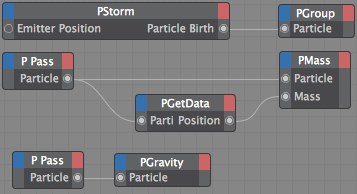Parameter
Here you can set the mass of particles and, optionally, specify how the mass changes over the life span of the particles.
Mass [0..+∞]
Variation [0..100%]
The mass that will be assigned to the particles. The higher the value, the greater the resistance to changes (inertia). You can vary the mass using Variation.
If Over Age is enabled, you can use the gradient to control the mass of particles based on their ages. For example, you can increase the mass of particles as they get older.
The left edge of the gradient represents the moment the particles are born and the right edge the moment they die. Thus, the gradient covers the life span of the particles. The brightness at a position on the graph acts as a multiplier for the Mass value.
To create a knot, click in an empty area below the gradient and a knot of the color at that position will be added. To change the color of a knot, double-click it and choose the desired color using the system color dialog. To remove a knot, Drag & drop it away from the gradient. The small diamonds on the gradient are bias handles and they pull the interpolation of the color knots from side to side for more control over how the gradient changes.
 Here we are changing the mass of a group of particles depending on how far away the particles are from the world origin. We’ve also put in a PGravity node with a little more work this could be a mass-dependent force field.
Here we are changing the mass of a group of particles depending on how far away the particles are from the world origin. We’ve also put in a PGravity node with a little more work this could be a mass-dependent force field.A Boole value of True switches the node on; a value of False switches it off.
Since the node’s parameters can be keyframe animated, by default the Cinema 4D time is used internally to ensure that the values are interpolated correctly. However, you can pass your own time value to this port. This should be of the data type Time, which is a Real number in the simplest case. If no value is passed, Cinema 4D’s time is used.
Connect this port to the stream of particles whose mass values you want to change, such as to the Particle output port of a PPass node.